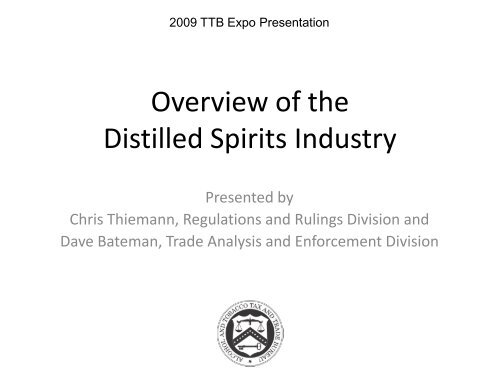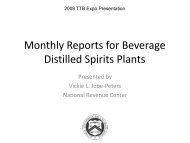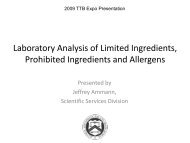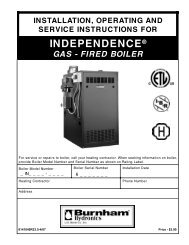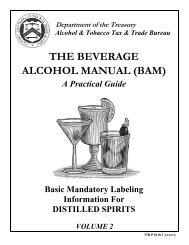Alcohol Industry Overview - Mountain Moonshine
Alcohol Industry Overview - Mountain Moonshine
Alcohol Industry Overview - Mountain Moonshine
Create successful ePaper yourself
Turn your PDF publications into a flip-book with our unique Google optimized e-Paper software.
2009 TTB Expo Presentation<br />
<strong>Overview</strong> of the<br />
Distilled Spirits <strong>Industry</strong><br />
Presented by<br />
Chris Thiemann, Regulations and Rulings Division and<br />
Dave Bateman, Trade Analysis and Enforcement Division
<strong>Overview</strong><br />
• TTB and the Distilled Spirits <strong>Industry</strong><br />
• Makeup of the Distilled Spirits <strong>Industry</strong><br />
• Current <strong>Industry</strong> Trends
TTB and the Distilled Spirits <strong>Industry</strong><br />
Chris Thiemann<br />
Regulations and Rulings Division
TTB and DSPs<br />
• TTB’s role in regulating the<br />
distilled spirits industry<br />
• DSP regulations and rulemaking updates<br />
• This week’s agenda
TTB’s Role<br />
• Qualifying manufacturers of beverage and industrial<br />
distilled spirits, producers of alcohol fuel, dealers of<br />
specially denatured alcohol, importers and<br />
wholesalers<br />
• Protecting the revenue (26 U.S.C. 5001)<br />
• Ensuring consumer protection (27 CFR part 5).<br />
• Ensuring fair trade practices (27CFR part 5)<br />
• Conducting quality audits and investigations
TTB’s Role (Continued)<br />
• Assisting industry members in understanding<br />
Federal laws and regulations as they relate to<br />
the industry<br />
• Assisting industry members in achieving<br />
compliance and satisfying tax liability<br />
• Processing MNBP drawback claims
TTB Organization
• Permits<br />
DSP Regulations<br />
• Physical characteristics of DSPs<br />
• Recordkeeping<br />
• Standards of identity<br />
• Labeling<br />
• Removal from bonded premises
DSP Regulations (Continued)<br />
• Industrial distilled spirits:<br />
– Specially Denatured <strong>Alcohol</strong> (SDA)<br />
– Completely Denatured <strong>Alcohol</strong> (CDA)<br />
– Manufacturers of Nonbeverage Products (MNBP)<br />
– <strong>Alcohol</strong> Fuel Plants<br />
– Users of Tax-Free <strong>Alcohol</strong>
• Part 19<br />
• Cachaça<br />
• Serving Facts<br />
Rulemaking Updates<br />
www.ttb.gov
The Distilled Spirits <strong>Industry</strong><br />
Dave Bateman<br />
Trade Analysis and Enforcement Division
The Distilled Spirits <strong>Industry</strong><br />
• The beverage alcohol industry in the U.S.<br />
contributed almost $448 billion to<br />
U.S. economic activity in 2006<br />
• 29% ($131 billion) was from distilled spirits
Distilled<br />
Spirits<br />
27%<br />
All Excise Tax Collections<br />
(Domestic and Imported)<br />
Fiscal Year ending September 30, 2008<br />
Wine<br />
5%<br />
FAET*<br />
2%<br />
Tobacco<br />
44%<br />
Beer<br />
22%<br />
* Firearms and Ammunition Excise Tax<br />
Tobacco is top tax category; Distilled spirits account for 27% of collections.
Excise Tax Collections for Imported Cased Goods,<br />
Taxes Collected by CBP<br />
Fiscal Year ending September 30, 2008<br />
Distilled<br />
Spirits<br />
54%<br />
FAET*<br />
0%<br />
Beer<br />
22%<br />
Wine<br />
11%<br />
Tobacco<br />
13%<br />
• Distilled Spirits is the top revenue producer on importations.<br />
• For October 2008 – January 2009, Distilled Spirits accounted for<br />
57.6% of import collections.<br />
* Firearms and Ammunition Excise Tax
The Distilled Spirits <strong>Industry</strong> (Continued)<br />
• Until 2009 the beverage distilled spirits industry had<br />
marked a total of 11 years of consecutive gains<br />
• DISCUS estimates industry-wide volume growth of<br />
2.8% for 2008, down from a nearly 6% increase in<br />
2007<br />
• Current tax receipts for the first quarter of FY 2009<br />
show a decline in domestic excise tax collections of<br />
2% and 5.3% imported bottled spirits, with an overall<br />
average decline of 3% .
Distilled Spirits Plants <strong>Alcohol</strong><br />
Usage Calendar Year 2006<br />
Fuel Ethanol<br />
Production at<br />
DSP's<br />
50%<br />
Taxable<br />
Withdrawals<br />
12% Tax Free<br />
5%<br />
Specially<br />
Denatured<br />
<strong>Alcohol</strong> and<br />
Rum<br />
12%<br />
Bottled for<br />
Export<br />
1%<br />
Completely<br />
Denatured<br />
<strong>Alcohol</strong><br />
20%
Nonbeverage <strong>Alcohol</strong><br />
• Ethanol consolidation:<br />
– After capacity under<br />
construction is<br />
completed, the top three<br />
U.S. ethanol producers<br />
will account for 35% of<br />
future U.S. ethanol<br />
production<br />
Top Three<br />
Producers<br />
65%<br />
Rest of Market<br />
35%<br />
Source: American Coalition for Ethanol
Ethanol Production (2006)<br />
<strong>Alcohol</strong> Fuel<br />
Plant<br />
Production<br />
64%<br />
Taxable<br />
Withdrawals<br />
4%<br />
Tax Free<br />
2%<br />
Bottled for<br />
Export<br />
0%<br />
Completely<br />
Denatured<br />
<strong>Alcohol</strong><br />
7%<br />
Specially<br />
Denatured<br />
<strong>Alcohol</strong> and<br />
Rum<br />
5%<br />
Fuel Ethanol<br />
Production at<br />
DSPs<br />
18%
Estimated Ethanol Production (2008)<br />
AFP Production<br />
82%<br />
Fuel Ethanol<br />
Production at<br />
DSPs<br />
9%<br />
Taxable<br />
Withdrawals<br />
2%<br />
Specially<br />
Denatured<br />
<strong>Alcohol</strong> and Rum<br />
2%<br />
Completely<br />
Denatured<br />
<strong>Alcohol</strong><br />
4% Bottled for Export<br />
0%<br />
Tax Free<br />
1%
Domestic DSP Activity<br />
Production for calendar year 2008:<br />
– Whiskey -5.0%<br />
– Brandy -1.3%<br />
– <strong>Alcohol</strong> +3.8%<br />
Total Production +3.2%
Millions of Gallons<br />
18000<br />
16000<br />
14000<br />
12000<br />
10000<br />
8000<br />
6000<br />
4000<br />
2000<br />
0<br />
Possible Overproduction of Ethanol<br />
Comparison of Production to Required<br />
Consumption<br />
2006 2007 2008 2009 2010 2011 2012<br />
Production 7200 10300 13500 14500 15000 16000 17000<br />
Renewable Fuel<br />
Standard<br />
3800 4600 5400 6000 7400 7400 7500<br />
Source: American Coalition for Ethanol Status Report 07<br />
These figures are the limits solely with the use of corn; new advances in<br />
cellulosic ethanol could produce 60 billion gallons of ethanol by 2029.
Seven States Account for 69% of Large AFPs<br />
ALL<br />
OTHER<br />
S<br />
31%<br />
WI<br />
5%<br />
IN<br />
5%<br />
KS<br />
7%<br />
SD<br />
8%<br />
IA<br />
19%<br />
NE<br />
13%<br />
MN<br />
12%<br />
(2007 data)
Compliance Concerns<br />
• Alternating proprietors<br />
• 5010 flavor tax credits:<br />
– TTB Expo session Friday afternoon<br />
• Gauging<br />
– Accuracy<br />
– Frequency<br />
• Reporting requirements
<strong>Industry</strong> Trends
<strong>Industry</strong> Trends<br />
• Beverage alcohol and the economy<br />
• <strong>Alcohol</strong> fuel plants/ethanol<br />
• Consolidation of manufacturers<br />
• Debate on lowering minimum age for alcohol<br />
purchases
State and Local Taxes<br />
• Increasing through much of the country<br />
Annual Tax Revenues<br />
Commodity Federal State Local<br />
Distilled Spirits $4.6 billion $5.7 billion $529 million<br />
Beer $3.7 billion $5.4 billion $1.09 billion<br />
Wine $877 million $1.6 billion $219 million<br />
Source: Distilled Spirits Council of the United States
The Economy Today<br />
• <strong>Alcohol</strong> is proving not to be a recession-proof<br />
product<br />
• Consumers are switching to value brands and<br />
larger package sizes<br />
• Bourbon is one of few exceptions
Exports<br />
• One bright spot for 2008 was growth in<br />
exports<br />
• U.S. exports in 2008 totaled $1.1 billion:<br />
– Primary exported products are whiskies, including<br />
Bourbon and Tennessee Whisky<br />
– Growth in Australia (+24.3%), Canada (+21.2%),<br />
France (+15.9%), Germany (+8.9%)<br />
– Emerging markets grew as well<br />
Source: Distilled Spirits Council of the United States
R&D Developments<br />
• From 2000 on, 5th still column<br />
• Molecular sieve column<br />
• Extractor column<br />
• Pressure column<br />
• Efficiencies increased 15% on yields<br />
• Fermentation process increased alcohol content<br />
to 14-16% ranges<br />
• Heatless distillation process — 2 columns:<br />
– Beer still<br />
– Molecular sieve/membrane column<br />
• Hydrolysis/cracking processes<br />
• Cellulosic ethanol production
Other Trends<br />
• Ethanol production is operating at capacity<br />
due to energy demands<br />
• Capital investment in ethanol plants is<br />
entering a new stage as the number of AFP’s<br />
under construction is slowing:<br />
– Farmers are planting capacity crops<br />
– Corn prices are stabilizing<br />
• New emerging industry — the Craft Distiller
Contact Information<br />
• Chris Thiemann<br />
Regulations and Rulings Division, Distilled Spirits Program<br />
– Phone: (202) 453-2138<br />
– E-mail: Christopher.Thiemann@ttb.gov<br />
• Dave Bateman<br />
Distilled Spirits <strong>Industry</strong> Analyst<br />
– Phone: (202) 302-3859<br />
– E-mail: Dave.Bateman@ttb.gov<br />
• Rob Crocker<br />
Excise Tax Auditor<br />
– Phone: (513) 826-0245<br />
– E-mail: Robert.Crocker@ttb.gov


